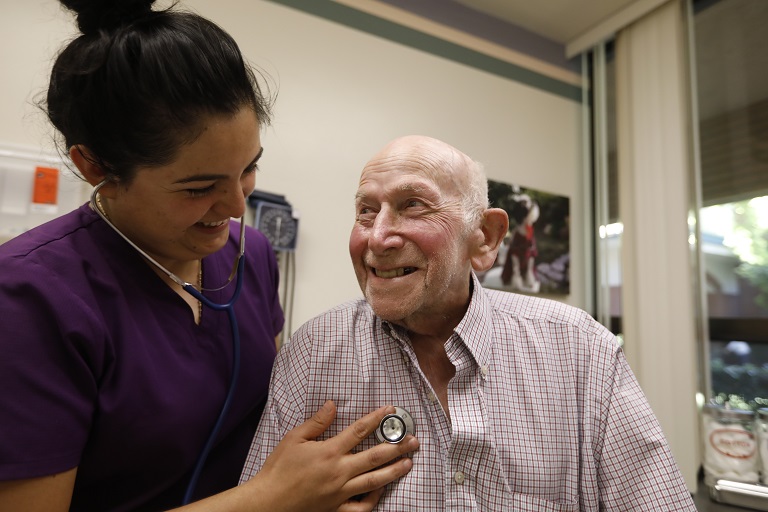When an artificial intelligence (AI) model takes a seat onstage alongside human panelists, you know the landscape has shifted. This year at the LeadingAge Annual Meeting, held Nov. 2-5 in Boston, that moment arrived. ChatGPT wasn’t just a topic of discussion; it was a panelist, responding in real time and modeling how generative AI can be harnessed as a direct participant in the work of aging services. It was symbolic and substantive, marking a turning point from years of talking about AI as a behind-the-scenes software feature to seeing it as an active collaborator in strategy, operations, and resident and staff experience.
For several years, conversations about AI in aging services have revolved around embedded algorithms used in fall detection sensors, electronic health record predictive models, or workflow automation, to name a few examples. These AI-driven systems helped, doing their work behind the scenes. What’s different now? Leaders and staff are the ones using generative AI tools. Not as a passive function inside products, but as a working partner helping to guide decisions, draft strategies, create training content, and support workflows.
Session after session at the Annual Meeting emphasized a striking theme: We’ve entered the execution era. Conversations have progressed. Providers are no longer asking, “What is generative AI?” They want to know: “Where is AI delivering value at scale?” Leaders shared real-world examples including AI-assisted referral summaries produced in minutes instead of hours, automated policy drafts, dementia care role-play scenarios, and micro-podcasts to support onboarding. These are not experiments. They are operational supports that save time and elevate staff performance, always with human review in the loop.
AI fluency has emerged as a necessary core competency. I heard of members launching departmental learning sprints and structured literacy programs to demystify AI and build trust. Frontline staff are experimenting hands-on. Executives are aligning AI governance and use to achieve organizational goals–without stifling creativity.
This isn’t tech for tech’s sake. It is a workforce strategy. In a sector facing chronic staffing challenges, leaders spoke frankly about using generative tools to reduce burnout, speed onboarding, and help teams feel more competent and supported. The message was clear that confidence comes from doing, not just knowing.
Residents Are Signaling their Expectations
If there was any doubt about older adults’ comfort with technology, the Elders Appreciation Luncheon held at the Annual Meeting erased it. I had the pleasure of giving the technology keynote to a crowd of more than 100 older adults and enjoyed engaging with such a diverse and dynamic group. The majority of attendees wore an Apple Watch, a visible reminder of how seamlessly technology has become part of their daily lives. When asked whether they’d rather wait on hold for a customer service representative or get instant help from an AI chatbot, they chose the bot, not because they preferred machines, but because they valued speed and clear answers. As one participant put it, the AI experience was “way better” than past human interactions.
This wasn’t about novelty. It was about dignity, control, and convenience, values that sit at the heart of person-centered care. Today’s residents expect technology to respond as quickly and intelligently as the rest of their digital lives, and they’re ready to embrace it when it meaningfully improves their experience.
Dining as a Model for Technology-enhanced Living
While AI commanded attention, innovation in dining illustrated how other technologies can elevate daily life. Leaders from Ingleside and RiverSpring Living shared how robotics, hydroponics, and smart kitchen systems are reshaping service, sustainability, and wellness. Robots deliver meals while staff stay focused on hospitality and connection. Hydroponic micro-farms, which allow for ultra-fresh greens to be grown onsite and harvested only minutes from the table, spark resident engagement. Digital dietary flagging in the Point of Sale (POS) system helps ensure residents receive food aligned to their unique needs. Cloud-based monitoring and digital labeling systems boost safety, reduce waste, and save hours of manual work.
What stood out wasn’t the technology itself but the care philosophy behind it. Tools were deployed thoughtfully to create safer work environments, empower staff, enhance dignity for residents on modified diets, and strengthen the emotional experience of shared meals. If you want a glimpse of where aging services is headed, look at how dining can be personalized, data-informed, sustainability-minded, and designed to celebrate daily life.
The Real Takeaway
AI is no longer a quiet background feature in aging services technology. It’s now a visible participant in how we communicate, plan, deliver services, and shape resident experiences. And while the tools are evolving fast, the values guiding their use are enduring empowerment, transparency, privacy, and humanity at the center.
This moment calls for thoughtful acceleration. Providers don’t need to rush into every use case, but they do need a strategy, a learning path, and a willingness to pilot. The organizations moving fastest aren’t chasing hype. They are clear on where AI helps their people thrive, and they’re building literacy and guardrails in parallel.
Generative AI won’t replace the compassionate, relationship-driven nature of aging services. But it is earning a role alongside the human touch. The organizations that treat AI as a trusted collaborator guided by mission, governed responsibly–and shaped with residents and staff at the table–will be the ones defining the next era of aging services.

 Shutdown Week Three: Impact of Ongoing Closure on Affordable Housing
Shutdown Week Three: Impact of Ongoing Closure on Affordable Housing


